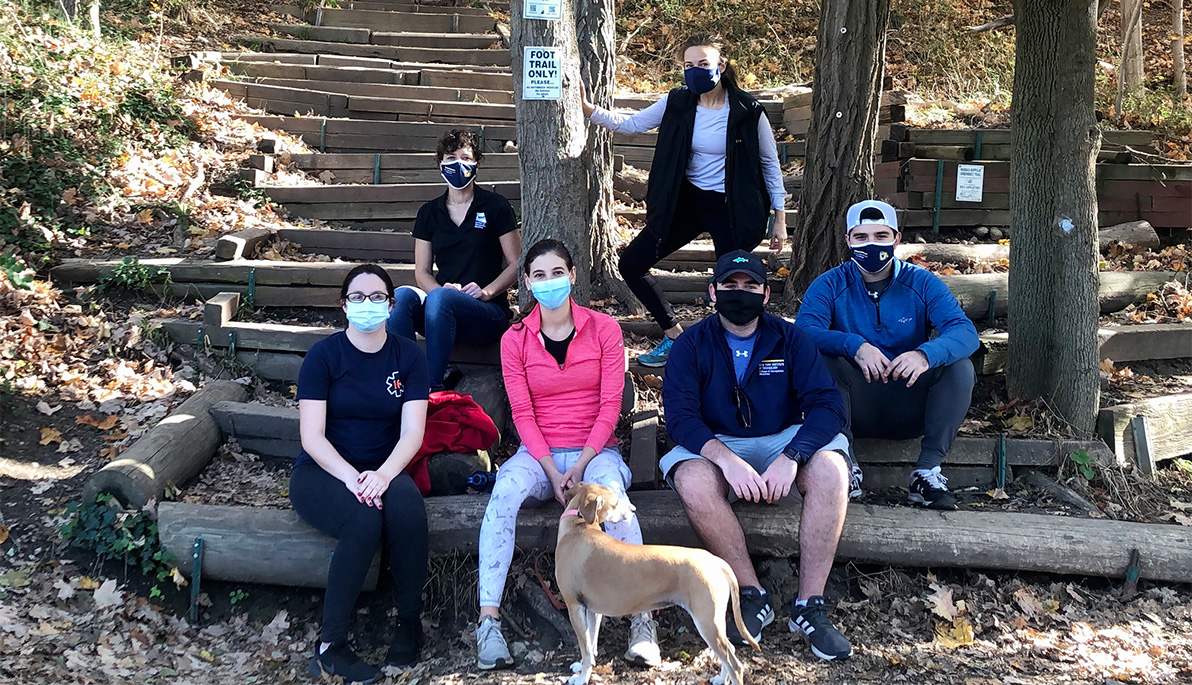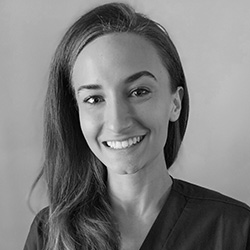
Student Profile: Kelly Borges

Major: D.O., Osteopathic Medicine/Ph.D., Medical and Biological Sciences
Year Expected to Graduate: 2027
Campus: Long Island
Hitting Her Stride
NYITCOM students and faculty safely socially distanced at a Fit Physician hike at Cold Spring Harbor State Park. Back row from left: Assistant Professor Julia Molnar, students Kelly Borges and Edward Modica. Front row from left: students Stephanie Pierce, Summer Rudish, and Nick O’Malley.
When Kelly Borges was searching for a medical school, she needed an institution that embraced and encouraged her active lifestyle. NYIT College of Osteopathic Medicine (NYITCOM) was just what the doctor ordered.
Although her medical school journey has only just begun, Borges has already managed to hit her stride—literally.
She’s involved with the Fit Physician program, an NYITCOM initiative that aims to help medical students integrate healthy habits into their routines and allow them to better manage the stress of rigorous coursework and exams. From mentored walks, runs, and hikes with NYITCOM faculty and leaders, to wellness seminars and activity monitoring, the program provides medical students with the techniques and awareness to one day help their future patients lead healthier lives.
Fresh off a socially distanced Fit Physician hike at Cold Spring Harbor State Park, Borges sat down with The Box to discuss her plans for medical school and how she aims to use her passion for wellness to help improve public health outcomes.
What led you to pursue a medical education?
While working on clinical research for my graduate degree at the University of Pennsylvania, I witnessed disturbing health disparities between the wealthy and the poor in Philadelphia. I also witnessed the effects of quality vs. unsatisfactory primary care on health outcomes. I’m pursuing a career in medicine to work toward decreasing those disparities through practicing and promoting evidence-based lifestyle interventions for chronic disease prevention and treatment.
Tell us about your involvement with Fit Physician.
I learned about Fit Physician and Rock Steady Boxing when I first toured campus. These programs distinguished NYITCOM among other schools I was considering at the time and influenced my decision to come here. At the start of the semester, I was encouraged by Dr. Jerry Balentine to serve as a student leader for Fit Physician. Little to his surprise, I’d already been in touch with Dr. Joanne Donoghue, who welcomed me to her team and to her ongoing research. Her dedication to improving the health of the medical community and beyond is extremely inspiring. Beyond encouraging my peers to exercise for their well-being, I plan to incorporate an exercise-related clinical research component to my studies as a D.O./Ph.D. student here.
What do you enjoy most about the Fit Physician program?
Fit Physician initiatives are unstoppable. The pandemic has presented challenges to nearly every aspect of life. Through this especially difficult in isolation, Fit Physician persists in the effort to keep students physically active. Utilizing the downloadable exercise tracking app, “Strava,” Fit Physician encourages students to complete monthly challenges (exercise goals tracked by minutes or miles) to get moving while fostering friendly competition among the four “Houses” each graduating class is divided into. Motivated by Fit Physician, Houses have hosted masked small-group walks, runs, and hikes on and off campus. For our upcoming challenge, we’re encouraging everyone to log at least four hours of any type of physical activity between November 7 and 27. I’m thrilled to be part of a community that has implemented physically distanced yet socially stimulating activities since the start of the pandemic.
We also heard that you joined a wellness nonprofit in presenting at a conference hosted by the American College of Sports Medicine. Tell us about that.
At the New England American College of Sports Medicine’s (ACSM) Fall 2020 conference, I gave a presentation entitled “Accelerating Systemic Addiction Recovery Using Dosed Exercise” alongside Fitness in Recovery’s cofounders, Dr. Sidra Ghafoor and John Breen. Fitness in Recovery is a 501(c)3 nonprofit organization dedicated to combatting addiction and mental illness through building physical competence and community. Since 2018, I’ve helped Fitness in Recovery affiliate with research institutions and introduce their exercise programming to in- and out-patient recovery centers in Philadelphia.
This year, we were welcomed by the ACSM to speak about our work as a contribution to their “Exercise is Medicine” content. Through their Exercise is Medicine global health initiative, the ACSM encourages clinicians to assess all patients’ physical activity levels as a vital sign. As an undergraduate member of the ACSM’s Alliance of Health and Fitness Professionals, I previously established a student-run chapter of the Exercise is Medicine initiative at the University of Connecticut to promote this mission at the campus clinic and to motivate healthy habit formation among college students. As a medical student and ACSM ambassador, I’ll continue to promote exercise for the prevention and therapy of physical and mental illness alike.
How will these fitness-related initiatives influence the impact you have on your future patients?
I’m convinced that virtually everyone can benefit from exercising regularly, yet I understand initiating an exercise routine can seem impossible for many people. That said, if my experiences with Fitness in Recovery and Back on My Feet have taught me anything, it is quite simply that where there is a will, there is a way.
My running buddy in South Philly was homeless when I met him. He showed up to every 5:30 a.m. run for the two years we ran together with Back on My Feet. His consistency in running built momentum in his life and ultimately helped him regain independence. He wasn’t a “runner” when he started but became one through open-mindedness and willpower. You don’t have to become a runner to reap the life-changing benefits of exercise; running is merely one of many ways to exercise. We’ve instilled this concept in Fitness in Recovery’s programming for introducing people overcoming mental illness and substance use disorders to exercise: where there is a will, there is a way. As a physician, I’ll take it as my responsibility to help my patients summon their will and discover their way.









